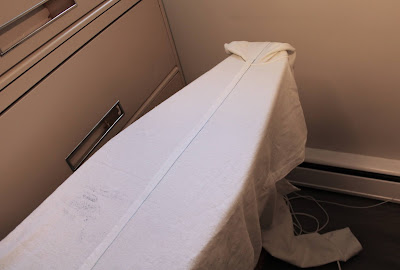Last year I posted some pictures of two extant nightgowns I got to examine in the King's Landing collection in late 2019, and I mentioned I'd taken measurements and drafted a pattern for one of them.
I cut out the pattern in 3 different fabrics not long after that, but they sat in the unfinished things pile for quite a long time, and I wanted to blog about all 3 at once. I have finally sewn all 3!
The second one I sewed was this white cotton flannel. It's a very thick old flannel sheet that I'd block printed some fish on, which can be seen in another blog post from 2017.
It's the one I took the most progress pictures of.
I started by sewing the cuffs to the sleeves, right side to wrong side, and understitched them, like on the original nightgown.
Sorry about the fuzzy dots, these were taken with my older camera.
I put the placket in more or less the usual way one puts in a placket, but did a couple rows of topstitching along the folded edge before sewing the other edges down.
I accidentally did the placket the wrong way around, so it overlaps right over left. Which isn't necessarily a bad thing, I think gendered button overlaps is a very silly concept, but it's not what I'm used to and is a bit more awkward for right handed people.
The yoke and collar are pretty similar to the way you'd sew them on a modern shirt, but there's no interfacing in the collar. As far as I could tell there wasn't any interfacing in the originals, and it makes sense, since they're for sleeping in and need to be comfortable rather than crisp looking.
Once the collar and yoke were all together I sewed the sleeves on, and felled the seam allowances.
Then it was time to sew up and fell the very long side/sleeve seam.
 |
| Pressing the side seam. |
They're printed with dye paste, so it doesn't affect the softness of the fabric.
There's a gusset reinforcing the bottom of the side seam on both original nightgowns, and they're sewn in differently from how I did this one. They look like they were done at the same time as the hemming, but I added mine on after, since I'm not an Edwardian factory worker doing things as efficiently as possible.
I machine sewed the buttonholes, added 5 big pearly plastic buttons, and it was done!
 |
| The original only had 3 small buttons, but I wanted more. |
The pattern I drafted was to the original measurements of the extant nightgown, and ended up fitting me pretty much perfectly! The only change I made to the pattern after first sewing it up was to shorten the sleeves by about 1 cm.
 |
| I put 4 red plastic buttons on this one. |
The third and most recent nightgown is in a dark brown mystery fabric which appears to be rayon, and which I think was also a gift from my mother. I felt it was too soft and floppy to bother doing a collar, so I left it off and just finished the neck with bias binding.
 |
| I did 7 little brown plastic buttons with horizontal holes. A bit more than usual, but there was a set of 7 in my stash. |
 |
| I clipped the seam allowance too high up, so the gusset isn't quite where I wanted it to be. |
I'll also hopefully get through some more of my sewing blog post backlog before the year is out...























































